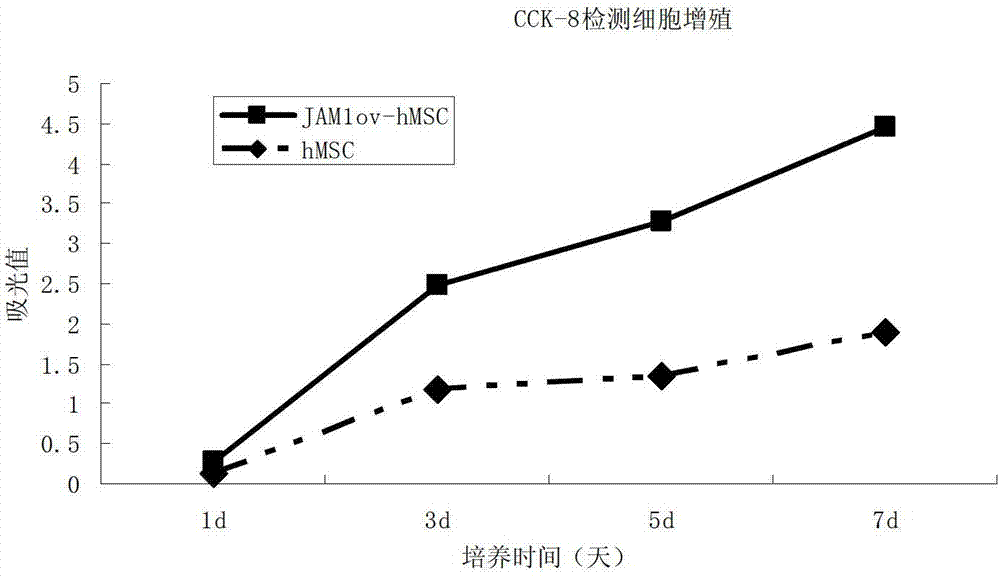Method of modifying mesenchymal stem cell by JAM1 gene and application thereof
A technology of mesenchymal stem cells and gene modification, applied in the field of stem cells and genetic engineering
- Summary
- Abstract
- Description
- Claims
- Application Information
AI Technical Summary
Problems solved by technology
Method used
Image
Examples
Embodiment 1
[0052] Example 1: The lentiviral overexpression plasmid pGC-FU-JAM1-GFP was constructed to infect human embryo-derived mesenchymal stem cells (hMSC).
[0053] 1. Preparation of total RNA from human epidermal cells
[0054] Adult human skin was obtained from the Plastic Surgery Department of Changhai Hospital. Epidermal cells were obtained from primary culture. The total RNA was obtained by extracting the total RNA by the conventional guanidine isothiocyanate method with the total RNA extraction kit of Shanghai Huashun Bioengineering Co., Ltd. Methods as below:
[0055] Take a 3.5cm-diameter dish of epidermal cells growing in a single layer, discard the medium directly, add 1ml of TRIzol to dissolve the cells, and remove the cell lysate with a pipette after the cells are fully dissolved. Incubate the cell lysate sample at 15-30°C for 5 minutes to completely decompose the ribosomes. Add 0.2ml chloroform per 1ml TRIzol, close the cap of the sample tube tightly, shake the tube...
Embodiment 2
[0106] Example 2: Cell experiment (in vitro experiment)
[0107] Using fluorescent microscope photography, CCK-8 experiment, flow cytometry, western-blot and other biological experimental methods, analyze cell morphology changes from various aspects such as cell morphology and protein expression, target gene expression and cell surface markers CD29, CD44 and Expression of CD90.
[0108] The specific method is as follows:
[0109] 1) Comparison of cell growth status
[0110] Visualization of Lentivirally Infected JAM1 Using an Inverted Fluorescence Microscopy ov - hMSCs and hMSCs. Cell morphology did not change significantly, such as figure 1 shown.
[0111] 2) CCK-8 detects cell proliferation
[0112] JAM1 ov - MSCs and MSCs were seeded in 96-well plates with 5000 cells per well, and CCK-8 working solution was added after 1 day, 3 days, 5 days and 7 days after culture (10 μL / well, 37 degrees, 5% CO2 incubator and incubated for 4 hours , measure the A450 absorbance valu...
Embodiment 3
[0133] Example 3: In vivo differentiation assay
[0134] Nude mice BALB / c Nu strain, SPF grade, were used in the experiment. Weight about 15 ~ 25g, 3 weeks old, purchased from Shanghai Experimental Animal Center. A total of 45 nude mice were divided into 3 groups: JAM1 ov - hMSC injection group, hMSC injection group, PBS injection group. 10 cells 4 0.15ml of the cell suspension was extracted with a 1ml syringe and injected subcutaneously into the back of the forelimb of the nude mouse. Feed under SPF conditions, observe daily, and collect samples 1, 3, 5, 7, and 14 days after transplantation. After 14 days, the cells injected with JAM1 overexpression had obvious hair formation.
[0135] Animals in each group had no difference in appearance, activity, etc. after the experimental treatment. Compared with nude mice in each group after sacrifice, there was no difference in H-E staining, liver, spleen, kidney and other organs.
[0136] H-E staining was performed on the skin ...
PUM
 Login to View More
Login to View More Abstract
Description
Claims
Application Information
 Login to View More
Login to View More - R&D
- Intellectual Property
- Life Sciences
- Materials
- Tech Scout
- Unparalleled Data Quality
- Higher Quality Content
- 60% Fewer Hallucinations
Browse by: Latest US Patents, China's latest patents, Technical Efficacy Thesaurus, Application Domain, Technology Topic, Popular Technical Reports.
© 2025 PatSnap. All rights reserved.Legal|Privacy policy|Modern Slavery Act Transparency Statement|Sitemap|About US| Contact US: help@patsnap.com



